Lives on the line
Cargill employees Alfred and Bernadette were among the many sickened by COVID-19 at the site of Canada’s largest outbreak. As they return to the meat plant post-recovery, fear of the disease lingers still.
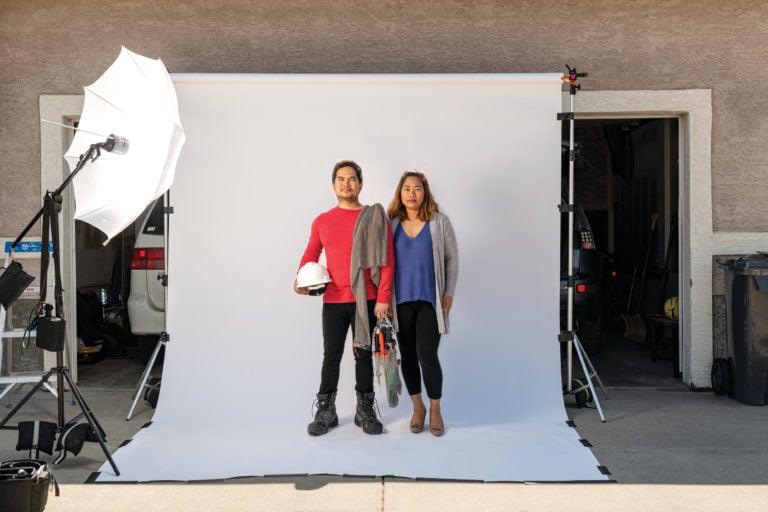
Cargill workers Gillo (left) and Pasco; they and their family have all recovered from COVID-19 (Photograph by Bryce Meyer)
Share
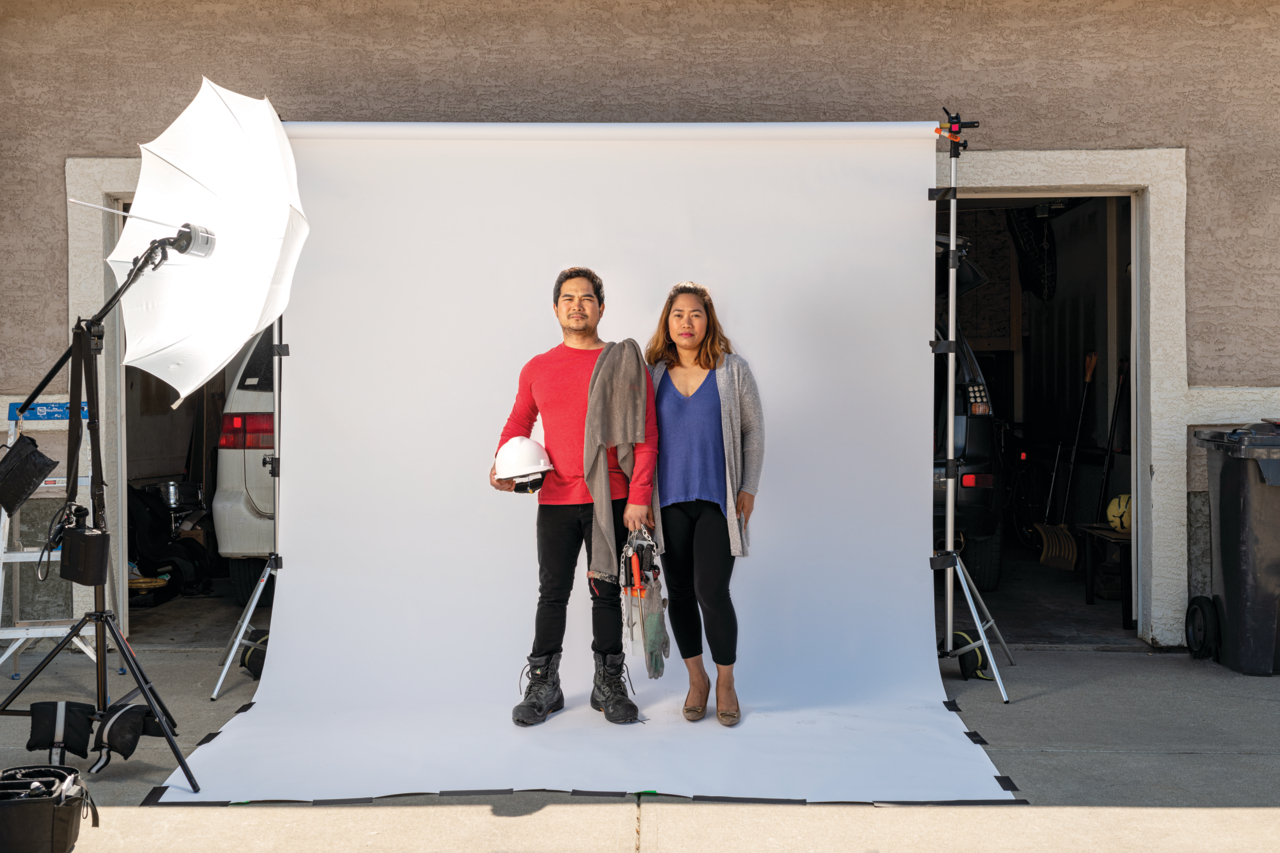
At around 3:30 p.m. on April 6, Alfred Gillo pulled his car into the parking lot at Cargill Ltd., a meat processing plant just outside High River, Alta., and walked toward his workplace.
He watched for his wife, Bernadette Pasco, who works the day shift, 7 a.m. to 4 p.m. Gillo works the night shift, 4 p.m. to 1 a.m., and if he times his arrival perfectly, he and Bernadette wave to each other during the shift change. That day, he didn’t see her.
Gillo, a saw operator, joined a line of other workers waiting to have their temperature checked by a security guard before entering the plant. When he got to the front of the line, the guard held a thermometer to his forehead for a reading and gave Gillo the all-clear. In the men’s locker room, Gillo pulled his personal protective equipment over his street clothes: a floor-length gown made of metallic mesh, two gloves (one of cotton, one of mesh) for his left hand, three gloves (two of cotton sandwiching one of mesh) for his right, a hairnet, a hard hat, safety goggles, earbuds and, finally, his steel-toed boots. He added a disposable face mask that he had purchased himself.
For most of the next eight hours, Gillo stood at a table between two colleagues cutting portions of beef to feed Canadians. As the evening wore on, he felt increasingly cold. That’s not unusual in a meat processing plant, where room temperatures are set low to preserve the meat. But on this night, something was different.
When he got home at 1:30 a.m., his body ached. He checked his temperature: 38.5° C. A fever.
***
Cargill, Canada’s largest meat processing plant, employs approximately 2,000 unionized workers, most of whom are immigrants, refugees or temporary foreign workers. Over a period of four weeks beginning in early April, Cargill became home to the largest outbreak of COVID-19 in Canada, with 945 workers infected by May 5. Another 600 cases of COVID-19 have been linked to the outbreak. One Cargill worker, Hiep Bui, and a family member of a Cargill worker have died. The plant shut down for two weeks in late April and reopened on May 4, over protests by the union.
[contextly_auto_sidebar]
Meat processing plants across the continent have become hot spots for the novel coronavirus. Only 200 km away from High River, workers at the JBS-owned slaughterhouse in Brooks, Alta., are falling sick at a rate far higher than the general population: 487 have been infected, and one employee has died of COVID-19. In British Columbia, outbreaks have been identified at four poultry plants, which have been closed on orders from local health authorities. In the United States, 20 meat packing plants have been closed temporarily because of the virus. The Centers for Disease Control and Prevention has reported that, in 115 meat or poultry processing facilities in 19 states, 4,913 workers have been diagnosed with COVID-19, and 20 have died from COVID-19-related causes. On April 28, President Donald Trump issued an executive order compelling meat processing plants to continue operating.
People who work at these plants are considered essential workers. By maintaining the country’s food supply, they are integral to the health and well-being of Canadians, just like doctors and first responders. And, just as at Cargill, many if not most of the country’s food supply workers are immigrants and temporary foreign workers. Between 50,000 and 60,000 temporary foreign workers arrive in Canada every year to work in agricultural, food or fish processing. When the country closed its borders to slow the spread of the virus in March, the Trudeau government issued an exemption for agri-food workers. They are still permitted to enter Canada, and are allowed to work following a 14-day quarantine.
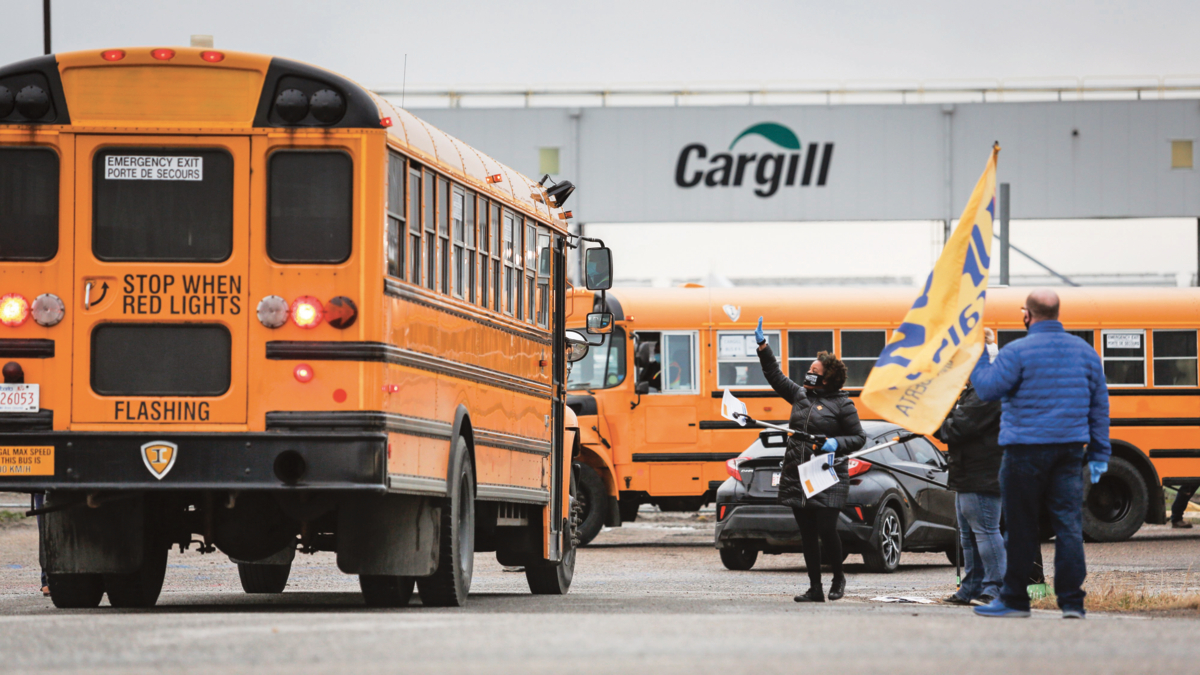
In response to a request for an interview, a spokesperson from Cargill directed Maclean’s to a statement issued on April 29 in which the company describes its employees as having been deemed essential workers—“like health-care providers and first responders”—and outlines the measures it took to keep them safe. But the outbreaks at Cargill and other meat plants raise the question of whether the plants’ employees are being properly protected. Are the risks they face properly addressed in light of such factors as language barriers, uncertainty about their futures in Canada and the challenge of social distancing for low-income people who live in small homes shared with multiple generations? Many Cargill workers, their union, their physicians and immigrant-serving agencies say the employer and other Canadians overlooked these risks. “These are things we need to ask after this crisis,” says Marichu Antonio, executive director of Calgary’s Action Dignity, an ethnocultural organization that is helping the communities disproportionately affected by the Cargill and JBS outbreaks. “The people who work in essential industries—we treat them like they are essential, but do we treat them with respect?”
***
Gillo, 39, was born and grew up in the Philippines. He is an only child, and his father worked as a painter. The family lacked money for things beyond basic food and housing. Gillo did not have the opportunity to go to college and worked in a supermarket in his home province of Bulacan. When he was 19, his first son was born. That’s when Gillo decided to move abroad for work. It was the best way to care for his parents and his son financially. “It was really hard to leave,” he says. “Filipinos, we are very attached to our family.”
READ: Quarantine nation: Inside the lockdown that will change Canada forever
In 2005, he moved to Kuwait where he met Bernadette, who was also from the Philippines. They got married and had a son in 2010. But Kuwait never felt like home. Gillo and his wife are devout Christians, and Kuwait was not an easy country in which to practise their faith. They learned about an agency in Vancouver that could help them find employment in Canada at a cost of $5,000 per person. The couple prayed together over what to do—they couldn’t afford to pay for both of them to move to Canada. They decided that Bernadette, who had a college education, would go first. She landed in Alberta in 2012 and started working at an A&W not far from High River as a temporary foreign worker. The following year, Gillo was approved for a spousal visa with an open work permit. Immediately after arriving in Canada, he started at Cargill as a meat cutter.
It’s physically exhausting work. For long hours and in cold conditions, he stands shoulder to shoulder with other workers, bumping up against the next body if anyone shifts in the line. Meat in various stages of processing makes first-timers at the plant retch from the pungency, while machines whir and bang in the background. When a supervisor needs to speak to someone working on the line, they lean in and put their mouth close to the worker’s ear, “like a kiss,” says Gillo.
***
Cargill opened its plant in High River in 1989, starting with 1,400 employees that worked one shift and processed 1,200 head of cattle a day. Today, the same facility processes around 4,500 head of cattle in 24 hours.
The safety protocols for the plant were not designed to reduce infection risk during a pandemic, says Sylvain Charlebois, scientific director of the Agri-food Analytics Lab at Dalhousie University. The chief safety considerations in a meat processing plant are food safety and the safety of workers from injury. “Physical distancing isn’t something they were thinking about,” Charlebois says.
Many newer meat processing facilities have more automation than this 31-year-old plant and, consequently, less human traffic on the floor, he says. The same is true at dairy processing or beverage plants where production is highly automated and comparatively few people work on the floor. Having visited both the JBS and Cargill plants in the past, Charlebois says he is “not overly surprised” at the outbreaks, given how employment works and the way the plants were designed.
On March 5, Dr. Deena Hinshaw, Alberta’s chief medical officer of health, announced the province’s first presumptive case of COVID-19, a woman who’d been a passenger on a Princess Cruises ship. The number of cases in Alberta began to rise, slowly at first and then more quickly. On March 17, the Alberta government declared a public health emergency.
Three days later, the union representing Cargill workers wrote a letter to the company calling for changes at the plant to create more distance between workers. In response, the company outlined steps they would take, including: placing anyone returning from international travel on a 14-day quarantine; adjusting break times so fewer people would be in the cafeteria at once; changing table configurations in the cafeteria; adding outdoor heated options for more spaces where people could take breaks; increased cleaning of common areas; and a $2-per-hour increase in pay, contingent on consistent attendance at work. Employees who completed all their scheduled shifts for eight weeks would receive a $500 bonus unless their absence was related to pre-scheduled vacation or COVID-19. Employees would also receive regular pay for up to 14 calendar days for time off due to COVID-19.
Gillo says he asked a supervisor for a mask but was told they were not necessary because social distancing measures were in place. He and Bernadette bought disposable face masks. They would wear them for a few days, and then wash them and dry them in the sun.
When Maclean’s asked Cargill for comment, company spokesperson Daniel Sullivan replied that “the use of masks has been consistent with the Alberta Health Services (AHS) guidance and requirements as they evolved.” He added that “the company has progressed from encouraging personal face masks to providing them and making their use mandatory based on health guidance.”
Inside the plant, it was impossible to socially distance, says Jamie Welsh-Rollo, a shop steward and part of the health and safety committee at the plant. In the cafeteria, people would crowd around 12 working microwaves, throwing in multiple meals at the same time. They sat at long picnic-style tables, set in rows with narrow gaps in between. Before and after every shift, hundreds of workers enter the locker rooms to put on or take off their gear. Maclean’s viewed a short video taken with a phone as someone walked through part of the men’s locker room. More than a dozen columns of green and beige lockers are stacked in rows of two, facing identical rows of lockers and creating little pods with benches in between. Men lay their gloves on the benches as they open their lockers or pull on jackets. At least 40 men briefly appear in the video. They are close enough to touch elbows as one walks by another on his way to a locker.
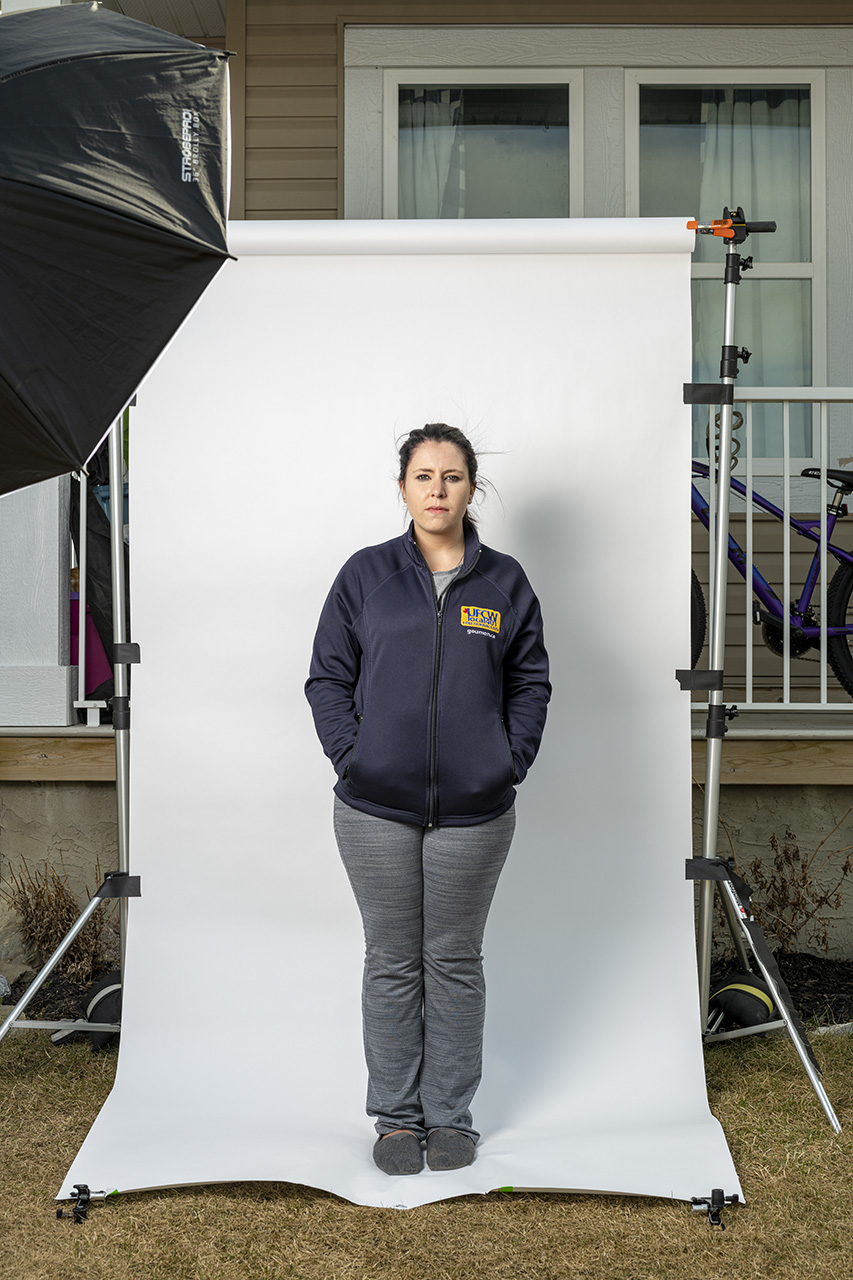
A single parent to a four-year-old son with an autoimmune condition, Welsh-Rollo was very worried about becoming infected with COVID-19. When the province moved into lockdown in March, her son’s daycare closed and she asked her grandparents, who are retired and live nearby, to help. At the end of a shift, she would go home and shower and change her clothes before she picked him up. At the end of March, she became ill with a runny nose, chest pains, a cough and bad headaches. She quarantined for two weeks but was never tested for COVID-19. At the time, Alberta’s protocol prioritized testing travellers, people who were hospitalized with respiratory illnesses, residents of continuing care homes and health-care workers. Food workers were not listed.
On April 6, testing expanded again to include anyone with COVID-19 symptoms on the front lines, specifically group home or shelter workers, first responders, those involved in COVID-19 enforcement, correctional staff and anyone 65 and older with symptoms. Again, food workers were not listed.
***
When Gillo awoke on the morning of April 7, he had a headache and still felt feverish. He called the nurses’ office at Cargill repeatedly but says no one answered. He had heard from colleagues that the company had set up a nursing tent outside the plant where they were swabbing employees, so he drove to the plant. A manager standing outside asked if he had symptoms, and Gillo said he did. In the tent, Gillo told the nurse he’d had a fever overnight. She gave him a note that said he needed to be isolated for 10 days, beginning immediately. She told him to stay indoors and away from the rest of his household.
The next morning, Bernadette had a cough. She called health services at the company. They didn’t answer so she left a message, explaining her situation. She stayed home at Alfred’s urging. Later that day, health services called back and told her to isolate.
Alfred and Bernadette confined themselves to their bedroom and shut the door to the rest of their family. On the other side, Bella, Bernadette’s 63-year-old mother, took over the cooking and chores. The couple worried about how she and their two boys, ages five and 10, were coping. Easter passed while they were in isolation. They prayed and took heart in the words of their pastor that God was not in a building, but in people who had faith. Members of their church dropped food for them on their front step.
READ: Dispatches from the coronavirus front lines: ‘I am afraid of what lies ahead for humanity’
In the second week of isolation, Bella knocked on their door and told them she did not feel well. Alfred and Bernadette again prayed over what to do, and decided to swap places with the rest of the family. Bella moved into her bedroom and the boys into theirs while Alfred and Bernadette took over running the household. People from their church continued to bring food, and the couple would leave portions outside their children’s and Bella’s doors. Several times a day, Alfred and Bernadette boiled water in a big pot with three tablespoons of salt and sat with it under a blanket, inhaling the vapours.
From his room, their youngest son cried to come out. Alfred stood in the hallway and tried to console him. That was one of the worst parts, he says. “It was heartbreaking for me.”
On April 13, a colleague whom Bernadette worked closely with called to say she’d tested positive for COVID-19. She encouraged the couple to be tested, and told them that an urgent care centre 25 km away in Okotoks was swabbing people. Alfred and Bernadette drove there for testing. The next day, they learned that they were positive.
***
Throughout April, the number of confirmed cases of COVID-19 among Cargill employees climbed by the day: one on April 6, 38 on the 13th, and 360 on April 20, with another 124 in the community. On April 19, Hiep Bui, a 67-year-old Vietnamese woman who’d worked at Cargill since 1996, died from COVID-19 in a Calgary hospital. She had become sick during her shift three days earlier. Action Dignity’s Antonio helped organize her cremation; Bui’s grieving husband was too ill.
Bui, like many of Cargill’s employees, lived in Calgary, 37 km north of the plant. Housing is more plentiful and cheaper in the city. And like many Cargill workers, especially on the night shift, Bui carpooled to work.
Dr. Annalee Coakley, the medical director at Calgary’s Mosaic Refugee Health Clinic, has several patients affected by the COVID-19 outbreak at Cargill. Some kept working even after they became sick. Coakley attributes this to multiple factors: fevers that came and went, a lack of translators, mixed messages about screening practices and a pervasive fear that workers would lose their jobs or not be paid if they stayed home with symptoms. “They’re living hand-to-mouth,” says Coakley. “If you expect them to follow these new rules about staying home, you also need to reassure them that they will not lose their job because of it.”
Coakley got involved in the province’s contact-tracing program around the time of Bui’s death, in an effort to help AHS address the unique needs of newcomers and immigrants unveiled by the Cargill outbreak. The public health messaging about COVID-19 in Alberta had not been translated into the first languages of many of the workers and their families, and culturally appropriate resources to help them to isolate and seek financial aid were lacking.
In the third week in April, local immigrant-serving agencies like the Calgary Catholic Immigration Society and Action Dignity pulled together a large team of volunteers to work with AHS and assist sick and isolated food-service workers. Volunteers from the Filipino, Eritrean, Ethiopian and Mexican communities coordinated with food banks to deliver two weeks’ worth of food to their homes. Rice for Filipino families. Oranges for families with kids. Fish that could go into soups. The Alberta International Medical Graduates Association, a group representing more than 1,000 foreign-trained physicians in the province, translated health information on COVID-19 into 19 different languages.
The outbreak also exposed the discrimination faced by many immigrant workers. One patient’s landlord asked her to move out because she worked at Cargill, says Coakley. Antonio at Action Dignity says some Filipino workers have been refused access to banks and grocery stores, even after being cleared by AHS. Racism is the untold story of this outbreak, says Antonio. “Getting the virus wasn’t their choice. Things like carpooling or living in the conditions that they do wasn’t their choice. It was what they had to do in order to survive.”
Dr. Amy Tan, a family physician in Calgary, cares for a large population of immigrant and refugee patients. While none of them work at Cargill, many work at other food processing plants or fast food restaurants. Some live in one-bedroom apartments with 10 family members. They regularly open their homes to acquaintances and family members who need places to stay. Many of them are people of colour employed by people who are not, Tan points out. They’re essential workers who live with other essential workers; some of her patients’ homes include both food workers and health-care workers.
Tan says governments and large corporations like Cargill failed food workers by putting them in high-risk situations and leaving it up to them to manage those risks at work and at home. “How can we ask them to navigate a system where they already do not feel safe and feel like they can’t speak up, and where they have limited financial means? How could we put that all on them?” Tan wants Canada to collect race and socioeconomic data during COVID-19. Without it, she says, the true numbers of Canada’s vulnerable or marginalized populations affected by the disease will never be known.
On the Friday before the plant’s scheduled reopening, Mussie Yemane, a volunteer with the Eritrean Canadian Community Association of Calgary, received calls from three workers who told him they were being instructed to return to work before their mandated periods of quarantine or self-isolation were complete. “They are being told to go in before AHS has said it is okay,” he says. Coakley says she had conversations with a Cargill nurse to clarify the requirement for self-isolation and quarantine. And Welsh-Rollo says many workers have not received full payment over the last weeks as they’ve been isolated, sick or waiting for the plant to reopen. As a shop steward, she has taken 60 complaints from people about pay.
Cargill spokesperson Sullivan told Maclean’s that “employees are encouraged to contact their HR representatives with any concerns they may have regarding work conditions, paid leaves or returning to work. We have been very clear that no employee is to return to work if they are sick or still under quarantine, and all workers are being screened before entering the facility. According to health officials, the majority of workers remain healthy, with 810 fully recovered.”
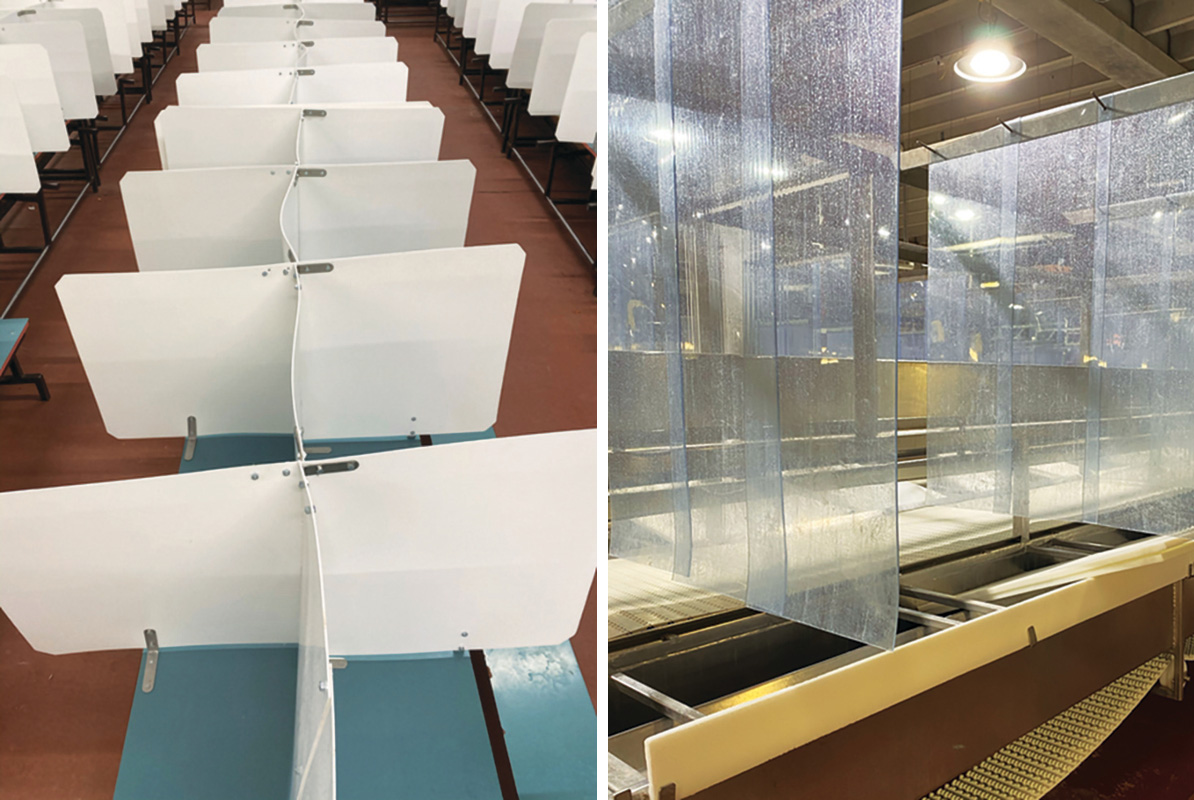
The statement Cargill issued on April 29 describes additional safety measures implemented during the two-week closure of the plant, including: limiting access to the plant to cars with no more than two people; providing transportation to the plant via buses with protective barriers between the seats; providing Occupational Health and Safety (OHS) with virtual and in-person tours of the plant; adding barriers in the bathrooms and reassigning lockers to allow for necessary spacing; and conducting extensive sanitation. The company also said that it had “continued to focus on education and awareness of social distancing inside and outside of work” and that this included “not sharing food during meals.” Cargill told Maclean’s that translators will be available for temporary foreign workers and that the company has been in regular contact with employees regarding pay.
The plant’s reopening is supported by AHS and OHS, which is conducting an investigation that will look at the circumstances surrounding potential exposure of workers at Cargill related to COVID-19, and any potential non-compliance that may have affected the health and safety of workers at the facility.
“The company is grateful for workers’ dedication and resilience as our plant and community walks through this heart-wrenching pandemic,” Sullivan told Maclean’s. “We are poignantly aware that being an essential worker is not easy.”
***
Gillo decided to speak on the record to Maclean’s about his experience because he believes people should understand. He says he is not afraid. He cites a favourite biblical phrase, Isaiah 41:10: Do not fear, for I am with you; do not be dismayed, for I am your God. And in Canada, people have the freedom to share their stories, he adds.
He understands why many of his co-workers do not feel comfortable speaking out, especially if they are not permanent residents. The family’s first four years in Canada were stressful. They were never certain of their future. Alfred needed to pass an English test to apply for permanent residency before his permit expired. He failed the first time. On Bernadette’s birthday in 2016, Gillo passed the exam. The next year, the family became permanent residents. “Thanks be to God, we were so happy,” he says.
Between Alfred and Bernadette, someone is at Cargill 18 hours a day—that’s why they look for each other at the shift change. They relish sacred time together on holidays and weekends. “On our normal Saturday and Sundays, we go to church, go shopping, we bond with our kids,” says Alfred. The family likes going camping and having barbecues, walking and biking. They own two used cars, one for each of them. “In Kuwait, we could not go outside. We didn’t have a car there. Even having a licence was really far beyond our imagination.” They send $250 to Gillo’s family in the Philippines each month. These are the reasons they work at the slaughterhouse. “That’s what we choose, even if it’s hard to work in Cargill.”
The family have all recovered from their symptoms. They’ve been cleared by AHS to return to work. Gillo worries that he could bring the virus home again. He’s heard of cases where people develop symptoms again after being cleared of the virus. There’s no certainty that he is immune. He told his supervisor he would like everyone to have a clear face shield to cover them from forehead to chin.
He and Bernadette decided that they cannot afford to stay home. “We’ll go back and we’ll pray. For sure, God is with us,” Gillo says. On May 6, he and his wife returned to work.
Editor’s note:
We hope you enjoyed reading this article, and that it added to your understanding of the ordinary and extraordinary ways Canadians are staring down this pandemic.
But quality journalism is not free. It’s built on the hard work and dedication of professional reporters, editors and production staff. We understand this crisis is likely taking a financial toll on you and your family, so we do not make this ask lightly. If you are able to afford it, a Maclean’s print subscription costs $24.95 a year — and in supporting us, you will help fund quality Canadian journalism in this historic moment.
Our magazine has endured for 115 years by investing in important stories and great writing. If you can, please make a contribution to our continued future and subscribe here.
Thank you.
Alison Uncles
Editor-in-Chief, Maclean’s